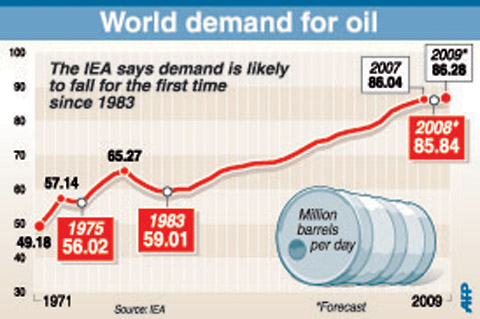Oil prices slid on Friday after the collapse of a US automakers bailout plan heightened worries about slowing demand as the global financial crisis bites.
Light sweet crude for delivery in January dropped US$1.70 a barrel to close at US$46.28 on the New York Mercantile Exchange.
On London’s InterContinental Exchange, Brent North Sea crude for January slipped US$0.98 to settle at US$46.41 a barrel.

AFP
Oil prices had soared more than 10 percent Thursday on signs that OPEC and Russia would cooperate next week in cutting production to support sagging prices.
“The beginning of a commodity rally that had included oil, may come to a halt as a consequence of the crisis of confidence in the wake of the bailout failure,” MF Global analyst John Kilduff said.
A US$14 billion plan to rescue ailing US automakers collapsed in the US Senate late on Thursday, raising the prospect of imminent bankruptcy for General Motors and Chrysler with millions of jobs at stake. The news weighed heavily on global stock markets on Friday, in turn depressing commodity prices.
“Crude futures tracked equity markets lower” on Friday, said Nimit Khamar, an analyst at Sucden brokers.
“Risk aversion set in after the auto industry bailout hit a snag,” Khamar said.
OPEC is widely expected to announce an output cut at a meeting on Wednesday in a bid to bolster prices that have plunged from record highs above US$147 in July.
OPEC, which pumps 40 percent of world crude, has called on non-members to play a role in reducing output to stem the sharp slide in crude prices of the last five months.
Russia said on Thursday it was ready to join forces with OPEC to stem the plunge in prices and could even become part of the oil cartel if membership were in Moscow’s interests.
Russia ranks alongside Saudi Arabia, de facto leader of OPEC, as the world’s largest oil exporter.
“The auto bailout failure will raise the specter of a deep recession as the ripple effect off the automakers supply chain spreads out. The paucity of credit may contract further as a consequence of the vast amount of debt issued by the car companies’ finance arms,” Kilduff said.
“The Treasury will be required to issue even more debt to cover the cost of the social fallout from expanded welfare, unemployment benefits, and pension guarantees,” he said.
Kilduff said Goldman Sachs oil analysts were issuing alarms months ago “super-spikes” to US$200 a barrel.
Those analysts “have now adopted the conclusion that we came to earlier this week: that the market was in a process of ‘bottoming,’” he said.

STILL COMMITTED: The US opposes any forced change to the ‘status quo’ in the Strait, but also does not seek conflict, US Secretary of State Marco Rubio said US President Donald Trump’s administration released US$5.3 billion in previously frozen foreign aid, including US$870 million in security exemptions for programs in Taiwan, a list of exemptions reviewed by Reuters showed. Trump ordered a 90-day pause on foreign aid shortly after taking office on Jan. 20, halting funding for everything from programs that fight starvation and deadly diseases to providing shelters for millions of displaced people across the globe. US Secretary of State Marco Rubio, who has said that all foreign assistance must align with Trump’s “America First” priorities, issued waivers late last month on military aid to Israel and Egypt, the

France’s nuclear-powered aircraft carrier and accompanying warships were in the Philippines yesterday after holding combat drills with Philippine forces in the disputed South China Sea in a show of firepower that would likely antagonize China. The Charles de Gaulle on Friday docked at Subic Bay, a former US naval base northwest of Manila, for a break after more than two months of deployment in the Indo-Pacific region. The French carrier engaged with security allies for contingency readiness and to promote regional security, including with Philippine forces, navy ships and fighter jets. They held anti-submarine warfare drills and aerial combat training on Friday in

COMBAT READINESS: The military is reviewing weaponry, personnel resources, and mobilization and recovery forces to adjust defense strategies, the defense minister said The military has released a photograph of Minister of National Defense Wellington Koo (顧立雄) appearing to sit beside a US general during the annual Han Kuang military exercises on Friday last week in a historic first. In the photo, Koo, who was presiding over the drills with high-level officers, appears to be sitting next to US Marine Corps Major General Jay Bargeron, the director of strategic planning and policy of the US Indo-Pacific Command, although only Bargeron’s name tag is visible in the seat as “J5 Maj General.” It is the first time the military has released a photo of an active

CHANGE OF MIND: The Chinese crew at first showed a willingness to cooperate, but later regretted that when the ship arrived at the port and refused to enter Togolese Republic-registered Chinese freighter Hong Tai (宏泰號) and its crew have been detained on suspicion of deliberately damaging a submarine cable connecting Taiwan proper and Penghu County, the Coast Guard Administration said in a statement yesterday. The case would be subject to a “national security-level investigation” by the Tainan District Prosecutors’ Office, it added. The administration said that it had been monitoring the ship since 7:10pm on Saturday when it appeared to be loitering in waters about 6 nautical miles (11km) northwest of Tainan’s Chiang Chun Fishing Port, adding that the ship’s location was about 0.5 nautical miles north of the No.